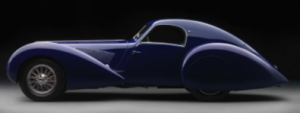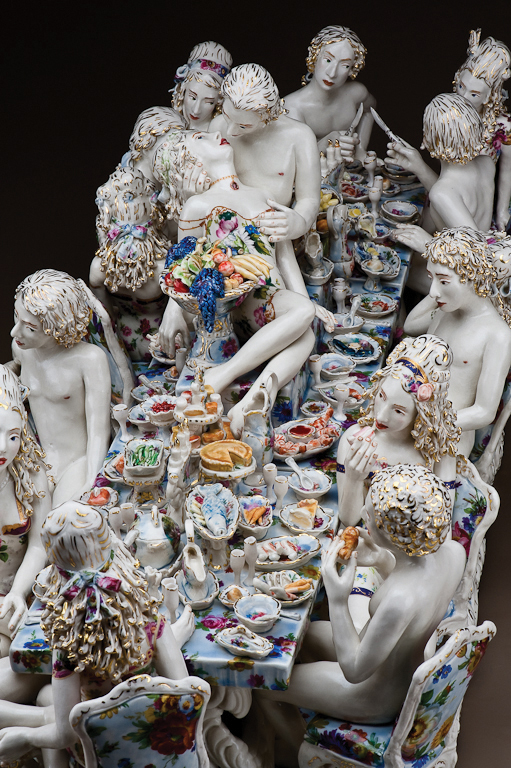By Bob Hicks
It’s Friday, the morning’s dead trees have been delivered, and they bear proof that Mr. Scatter’s been a busy beaver lately (although he does not claim responsibility for chewing through the timber that became the newsprint that bears his words).
 Friday’s A&E magazine of The Oregonian includes Beautiful Bodies, Mr. Scatter’s cover story on the Portland Art Museum‘s new show The Allure of the Automobile, plus a review of Richard Barnes’s new show of behind-the-scenes photographs of natural history museums at Blue Sky Gallery and a brief look at the first group photo exhibit in the new gallery space at Newspace Center for Photography. Such a lot of stuff!
Friday’s A&E magazine of The Oregonian includes Beautiful Bodies, Mr. Scatter’s cover story on the Portland Art Museum‘s new show The Allure of the Automobile, plus a review of Richard Barnes’s new show of behind-the-scenes photographs of natural history museums at Blue Sky Gallery and a brief look at the first group photo exhibit in the new gallery space at Newspace Center for Photography. Such a lot of stuff!
Since the cars are hogging the cover, let’s take a look at Barnes’s beasts first.
This is a very cool show, and AS recommends you take a look when you get a chance. The images are gorgeous, and they put into play the ways that museums manipulate reality in order to tell a story. (This is not necessarily a bad thing.) The photo at top, Flayed Man, prompted this little outpouring from Mr. Scatter’s metaphorical pen: “It’s one thing for medical students to slice apart cadavers to learn the necessary tricks of the trade. It’s quite another for bodies, those magnificent receptacles of what once was human life, to be pickled and posed and put on display for human entertainment. It suggests a fundamental lack of respect for what is, after all, individual human history.” Maybe you feel differently. Hit that comment button and let us know.
*
 Meanwhile, almost lost in the glamour of the rare-car show, the museum also opens its exhibition of the newest Contemporary Northwest Art Awards on Saturday. In the long run, this show might be more important to the museum than Allure, although it’s doubtful it’ll generate the long lines waiting to get in. It’s the first of these award shows in new Northwest art curator Bonnie Laing-Malcolmson’s tenure, and as a result people are looking closely, trying to divine what her aesthetic might be and what it will mean. That’s a lot of weight to put on a single show, but there you have it. Mr. Scatter promises to visit it, and probably write about it, very soon. The seven artists selected: Chris Antemann, John Buck, John Grade, Jerry Iverson, Susie Lee, Megan Murphy, and Michelle Ross.
Meanwhile, almost lost in the glamour of the rare-car show, the museum also opens its exhibition of the newest Contemporary Northwest Art Awards on Saturday. In the long run, this show might be more important to the museum than Allure, although it’s doubtful it’ll generate the long lines waiting to get in. It’s the first of these award shows in new Northwest art curator Bonnie Laing-Malcolmson’s tenure, and as a result people are looking closely, trying to divine what her aesthetic might be and what it will mean. That’s a lot of weight to put on a single show, but there you have it. Mr. Scatter promises to visit it, and probably write about it, very soon. The seven artists selected: Chris Antemann, John Buck, John Grade, Jerry Iverson, Susie Lee, Megan Murphy, and Michelle Ross.
*
About those cars.
The online version of the A&E story prompted this pained response from one reader: “And next up, what, Portland Art Museum will veer off-mission to exhibit exotic animals doing tricks? Naked ladies mud wrestling? Cute puppies in sequined outfits? Those spectacles would get great box office, too. With so many other “jumped shark” feats of desperate daring-do, PAM could just forget about actual art and have ’em lined up around the corner!”
Truth be told, before he began to look into the show Mr. Scatter wondered a bit along the same lines, though he hopes in slightly less purple or outraged tones (and with “daring-do” spelled correctly, if prosaically, as “derring-do”). Can cars be art? Are they simply engineering? Are even these rare examples nothing but the playthings of the rich? Where is the individual artist, as opposed to the corporate designer, in this process?
The answers he came to, at least tentatively:
- Yes, cars can be art. Why not? All sorts of art is also utilitarian (although some people persist in calling such things “craft”).
- Engineering — or, in broader terms, skill and technique — is an important aspect of art: not the impulse, but the engine.
- So what if the owners are rich? Who do you think Rembrandt and Holbein were painting for? Who buys Matisses, Warhols, Damien Hirsts? One of the glories of museums is that they collect beautiful and important things made for or bought by wealthy people and make them accessible to almost anyone. Surely Karl Marx must have approved: Museums redistribute a culture’s aesthetic wealth. From each according to his ability to pay, to each according to his need to experience.
- No, these aren’t individual statements in the way that an artist-decorated hippie van or a graphically painted lowrider sedan can be. Then again, all sorts of artists, especially sculptors, have some or all of their work fabricated by artisans. Is it right for Donald Judd but wrong for Ettori Bugatti? And is it not pertinent that almost all of these cars are either one-offs or (to borrow an art-world term) limited-edition prints?
Mr. Scatter realized that he was suspicious of cars being considered art because (a) cars are objects of pleasure, and (b) all sorts of people who wouldn’t ordinarily dream of walking into an art museum are fascinated by beautiful cars. And then he thought: (a) but isn’t art intrinsically about pleasure, even when its subject matter is harsh?, and, (b) isn’t it possible that populist appeal simply means something is a very successful work of art? Is Abbey Road less artful because zillions of people, many without music degrees, have listened to it? (The converse, of course, isn’t true: the fact that something is popular doesn’t automatically mean it’s also good.)
 Another issue comes to bear: Where does design fit on the arbitrary totem pole of aesthetic prestige? These automobiles are masterworks of design, no less so than any number of objects anointed in the permanent collections of the Museum of Modern Art. Maybe an exhibit about automobiles would seem a little less out of joint in Portland if the Portland Art Museum had a tradition, as so many museums do, of displaying decorative art. In fact, the museum has no decorative-art division, although a decent share of its holdings is in fact decorative, at least to some degree. Much of the amazing clothing in the Native American collections, for instance, can be thought of in decorative terms. Perhaps the museum ought at some point to name a curator of decorative arts, who could begin with the silver collection, dip into the Asian and Native American collections, look at the rest of what’s on hand and begin to assemble shows based on decorative themes. Perhaps then the Portland audience might begin to develop a broader appreciation of the various kinds of expression that the word “art” can embrace.
Another issue comes to bear: Where does design fit on the arbitrary totem pole of aesthetic prestige? These automobiles are masterworks of design, no less so than any number of objects anointed in the permanent collections of the Museum of Modern Art. Maybe an exhibit about automobiles would seem a little less out of joint in Portland if the Portland Art Museum had a tradition, as so many museums do, of displaying decorative art. In fact, the museum has no decorative-art division, although a decent share of its holdings is in fact decorative, at least to some degree. Much of the amazing clothing in the Native American collections, for instance, can be thought of in decorative terms. Perhaps the museum ought at some point to name a curator of decorative arts, who could begin with the silver collection, dip into the Asian and Native American collections, look at the rest of what’s on hand and begin to assemble shows based on decorative themes. Perhaps then the Portland audience might begin to develop a broader appreciation of the various kinds of expression that the word “art” can embrace.
And one thing more: The Portland Art Museum is a general art museum. That covers a lot of sins. And, thank goodness, a whole lot of possibilities.
*
ILLUSTRATIONS, from top:
- Richard Barnes, “Flayed Man,” 2005, C-Print, 48 x 60 inches. At Blue Sky Gallery. Image © Richard Barnes.
- 1937 Talbot-Lago T150-C-SS “Teardrop†Coupe, “The Allure of the Automobile,” Portland Art Museum. Lent by Arturo and Deborah Keller, Petaluma, California.Chris Antemann, “Feast of Impropriety” (detail), 2010, 3-section centerpiece, dining table with 16 figures; porcelain with decals, luster and china paint. Contemporary Northwest Art Awards, Portland Art Museum.1937 Hispano Suiza H-6C “Xenia†Coupe, “The Allure of the Automobile,” Portland Art Museum. Lent by Merle and Peter Mullin and the Peter Mullin Automotive Museum Foundation, Beverly Hills, California.
